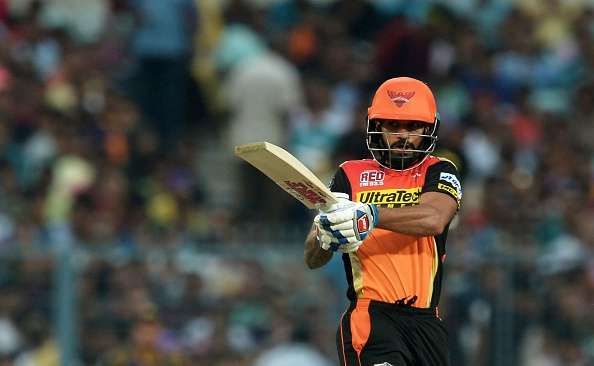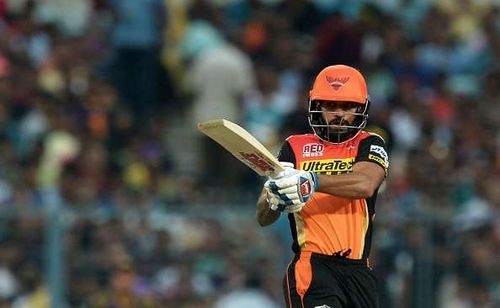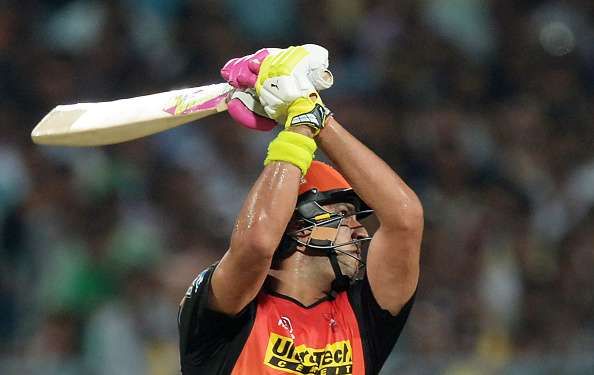
IPL 2017: How much did Shikhar Dhawan contribute to SRH's defeat against MI?

Sunrisers Hyderabad’s clash against Mumbai Indians was a story of two halves. After a confident and promising opening stand between Warner and Dhawan, Hyderabad lost momentum in the middle overs, courtesy of quick wickets and finished without any considerable flourish at the end.
For Hyderabad, first ten overs produced 75 runs while the next ten yielded mere 83. The lack of acceleration in the latter part of the innings proved monumental for Sunrisers as they lost the game by four wickets.
Most of the blame for this batting failure was credited to Shikhar Dhawan, who scored 48 runs off 43 balls. The southpaw’s slow start and failure to step up after Warner’s fall was seen as the prime reason for the team’s batting debacle.
In T20, where scoring 20 runs of one over has become a norm rather than an exception, playing 43 deliveries at the strike rate of only 111.62 does sound like a heinous crime.
Keeping aside Dhawan’s contribution, Hyderabad scored 110 runs from 77 balls, at a strike rate of 142.85. This rate of striking is well ahead of their overall innings strike rate of 131.66. Mumbai achieved the target in the 19th over, giving an impression that Hyderabad was around 20 to 25 runs short.
From outside, it does look that the blame for not taking the team through lies with the Delhi batsman, as he faced 35.83% of total team deliveries but managed to get only 30.37% of total team runs.
What Shikhar was actually trying to do was to play the role of sheet anchor. With Warner, Hooda, Yuvraj and Cutting in the batting line up, the game plan may have been for the Delhi left-hander to hold on to one end and the other batsmen playing strokes from the other.
In reality, the Indian opener fumbled with the strategy and ended up being the Achilles heel. Blaming Dhawan’s efforts puts a huge question mark on the idea of an anchor in a T20 game.
Also Read: IPL 2017: Mumbai Indians vs Sunrisers Hyderabad, Player ratings
If we go by statistics, in most of the games, strike rate of the sheet anchor will be lesser compared to other batsmen and due to his role of guarding one end, he would end up playing the most number of balls as well. Hence, the impression that the anchor actually denied the team few extra runs courtesy of his conservative batting approach will remain forever.
The Kings XI Punjab of 2014, with Maxwell and Miller, have proved that in T20, teams can do equally well without a sheet anchor. In fact, the fearless aproach helps the side post mammoth totals.
Has ‘all out aggression’ policy limited the need for a sheet anchor in T20?

To some effect, it has. On flat pitches, where batsmen can play strokes freely, this approach sounds foolproof. But it may backfire when pitches become slower and have something for bowlers in them. On such tracks, the idea of having seven to eight hitters can actually end up in a batting collapse.
While questioning Dhawan’s innings of 48, one cannot afford to ignore Nitesh Rana’s innings in the same match. His numbers are somewhat similar to Dhawan’s but his strike rate is slightly ahead of the SRH batsman. Rana scored 45 runs off 36 balls at the strike rate of 125.
But anyone hardly pointed fingers towards the Delhi youngster, only because he was a part of the winning side. Although both Rana and Dhawan played in a similar fashion, the difference that decided the fate of their respective innings was the contribution of other batsmen.
Firstly, Parthiv scored a brisk 39 off just 24 balls at the top and later Krunal Pandya played a cameo of 37 runs from only 20 balls. These two knocks helped Mumbai cross the line and ensured Rana’s contribution didn’t go waste.
In the case of the 31-year-old Sunriserers’ opener, except for Warner’s 49 from 34 balls, there was no other considerable support. For Dhawan’s efforts to yield results, the defending champions needed an innings like Pandya’s. After Warner’s demise, barring the Delhite, Sunrisers batsmen faced 43 balls, but scored only 50 runs.
With the Indian opener holding on to one end, the stage was set for the middle order to play their natural game and propel SRH to a big score. However, after Warner, none of the batsmen took the responsibility and SRH ended up scoring just 158 runs, not enough on a batting paradise.
Dhawan may receive flak for not scoring runs at a brisk pace, but the SRH middle order is equally responsible for the four-wicket loss.